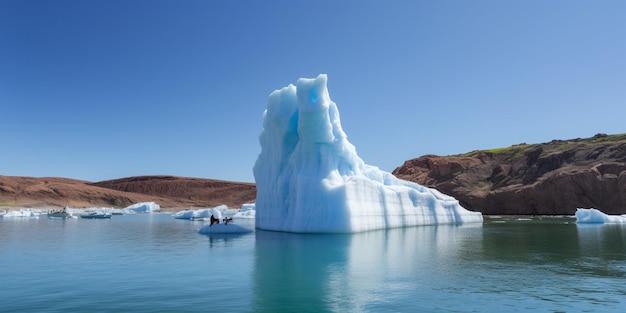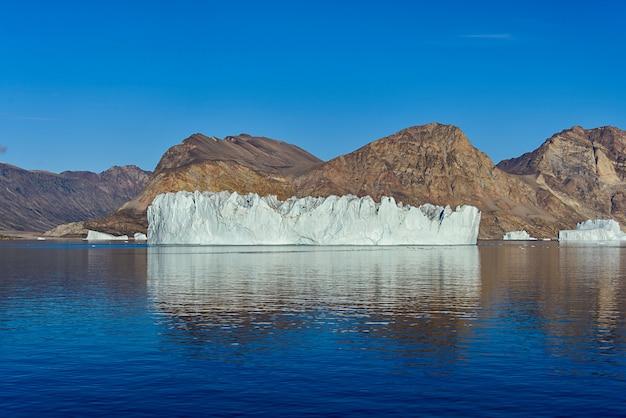Glaciers have played a vital role in shaping the Earth’s landscapes over millions of years. These gigantic ice masses may appear static and immovable, but they possess an incredible power to mold and transform the land they inhabit. In the northeast region, glaciers have left an indelible mark, leaving behind a legacy of awe-inspiring landforms. From majestic mountain ranges to deep valleys and stunning lakes, the fingerprints of glaciers can be seen throughout this picturesque corner of the world.
As we delve into the fascinating world of glaciers and their impact on the northeast region, we will explore the mechanisms of their movement, the remarkable landforms they create, and the profound changes that have taken place over the course of ages. Through this blog post, we will gain a deeper understanding of how glaciers have shaped the natural wonders we admire today. So, let’s embark on a glacial journey to uncover the secrets of the northeast region’s captivating terrain.
How Glacial Forces Sculpted the Northeast Region
Glaciers, those massive frozen rivers of ice, have shaped our planet in remarkable ways. The northeast region of the United States is no exception. Let’s dive into the fascinating story of how glaciers transformed the land we now call home.
The Glacial Sculptors Arrive
Around 20,000 years ago, during a time known as the Last Glacial Maximum, the northeast region experienced a chilly makeover. Enormous glaciers, several thousand feet thick, advanced from the north, exerting their icy grip on the landscape.
Bulldozing Mountains with Ice
As the glaciers inched their way forward, they bulldozed everything in their path. Mountain ranges, like the Green and White Mountains, were no match for these icy behemoths. The relentless pressure and movement of the glaciers scraped away the top layers of earth, leaving behind deep valleys and stunning ridges, which we now admire as part of our breathtaking scenery.
Carving Out the Great Lakes
Not only did these glaciers reshape the land, but they also played a pivotal role in forming the Great Lakes. As the massive sheets of ice advanced and retreated, they scooped out deep depressions in the earth, eventually filling them with meltwater to create the Great Lakes we cherish today.
Glacial Artistry: The Finger Lakes
In upstate New York, a cluster of freshwater lakes captivate visitors with their stunning beauty. These are the Finger Lakes, and their unique shape is a testament to the creative power of glaciers. The long, narrow lakes were gouged out by the moving ice, leaving behind a series of parallel valleys that resemble the fingers on a hand.
Divine Waterfalls of the Northeast
Glaciers didn’t just carve valleys and lakes; they also left behind mesmerizing waterfalls. Take, for example, the famous Niagara Falls. These thundering cascades are a testament to the raw strength of the glacial forces that sculpted the region. As the glaciers receded, they unleashed vast quantities of trapped water, which cascaded over steep cliffs, creating the awe-inspiring waterfalls we flock to witness today.
A Bountiful Legacy
Glacial activities in the northeast left a lasting impact on the region’s natural resources and diversity. The retreating ice sheets left behind fertile soil, ideal for agriculture. The abundance of freshwater lakes and rivers supplied the region with a wealth of aquatic resources, supporting diverse ecosystems and sustaining human populations throughout history.
Unraveling the Glacial Mysteries
Studying the effects of glaciers is like exploring a captivating detective story carved into the landscape. Scientists and geologists continue to unlock the secrets hidden within the northeast’s glacial past, piecing together the timeline of events and unravelling the mysteries of our geological history.
So, the next time you find yourself standing in awe of the northeast region’s breathtaking landscapes and natural wonders, remember to thank the glaciers that sculpted it all. Without their icy touch, this corner of the United States wouldn’t boast such stunning beauty.
FAQ: How did glaciers change the land of the northeast region
What is the movement of glaciers
Glaciers are large masses of ice that move slowly down valleys, shaped by gravity and the pressure of their own weight. This movement is called glacier flow, and it can be likened to a slow-motion river of ice. Don’t expect glaciers to win any sprinting competitions though, they make the tortoise look like Usain Bolt!
What landforms are created by glaciers
Glaciers work wonders when it comes to reshaping the land. They can carve out majestic valleys, like nature’s own sculptor. They create breathtaking fjords and stunning U-shaped valleys that are simply picture-perfect. And let’s not forget about those impressive cirques, hanging valleys, and moraines – these icy architects really know how to create a dramatic landscape!
Which country has no glaciers
Every country deserves a cool spot, but believe it or not, the tropical paradise of Jamaica prefers sipping piña coladas over chilling with glaciers. So, if you’re in the mood for sunshine and reggae music, you won’t find any glaciers on this beautiful island.
What is the iceberg
Ah, the iceberg – nature’s naughty little surprise! Icebergs are giant chunks of ice that break off from glaciers and float freely in the ocean. It’s like those ice cubes you forget in your drink, but on a colossal scale! Just remember, they may look harmless from afar, but beneath the surface, they hide a chunk of ice that would make your freezer jealous.
How did glaciers change the land of the northeast region
Picture this: massive sheets of ice, slowly but surely, making their way across the land. Glaciers in the northeast region of the United States were like giant bulldozers, redefining the landscape. They scraped away soil and rock, leaving us with the impressive Great Lakes and the beautiful Finger Lakes. And let’s not forget about those captivating drumlins and expansive outwash plains. Thanks to glaciers, the northeast region got more than just its fair share of glacial glamour!
Can you see a glacier move
As much as we’d love to witness the icy ballet of a glacier right before our eyes, their movement happens at an agonizingly slow pace. If you’re not in possession of a time-lapse camera set to record for a few millennia, you might have a hard time noticing their movement. But hey, that just gives us more time to appreciate their stunning beauty.
What is the fastest slowest glacier in the world
Hold onto your ice axes, folks! The fastest glacier in the world is the Jakobshavn Glacier in Greenland, which speeds along at a brisk 14 kilometers per year. On the other end of the spectrum, we have the frozen snail known as the Stor-Raudfjord Glacier in Norway, creeping along at a glacial pace of just 2 centimeters per year. Hey, life’s all about balance, even for glaciers!
How many years did the Ice Age last
The Ice Age sounds like a pretty epic party, but it lasted for a mind-boggling 2.6 million years! That’s a lot of time for mammoths to perfect their disco moves and cave artists to brush up on their rock art skills. But thankfully, the Ice Age eventually ended, allowing humans to embrace warmer climates and invent things like ice cream.
What is the world’s fastest-moving glacier
If glaciers participated in the Olympics, the world record for the fastest-moving glacier would go to the Perito Moreno Glacier in Argentina. This icy sprinter clocks in at a speedy 700 meters per year. Imagine Usain Bolt with spikes on his shoes running on a frozen track, and you’ll get the picture. Impressive, right?
What is the largest glacier in Africa
When you think of Africa, snow-capped mountains and glaciers might not be the first things that come to mind. But surprise! Africa has its very own icy wonder called the Furtwängler Glacier. Nestled on Mount Kilimanjaro in Tanzania, it’s the largest glacier in Africa, defying expectations and serving up frozen beauty in an unexpected place.
Which is the largest glacier in the world
When it comes to the title of the largest glacier in the world, the crown goes to the Lambert Glacier in Antarctica. Spanning a massive 60 miles wide and nearly 250 miles long, this frozen behemoth could give the Hulk a run for his money. It’s so immense that it puts the “ice” in “nice”!
What happens if glaciers disappear
If glaciers were to vanish completely, it would be like saying goodbye to some of our planet’s most important water reserves. Not only would we lose those iconic icy landscapes, but the water levels in oceans and lakes would rise. And that’s no laughing matter, my friend. It’s a wake-up call for us to take action and ensure the survival of these frozen giants.
Can global warming cause extinction
Global warming is no laughing matter when it comes to the future of life on Earth. It threatens the survival of many species, including polar bears, penguins, and various marine life. So let’s join forces, become environmental superheroes, and spread the message of conserving our planet, one ice cube at a time!
How did glaciers affect North America
Glaciers didn’t just wave hello and move on when it came to North America. Oh no, they made a lasting impact! They shaped the land, creating breathtaking features like the Great Lakes, stunning fjords, and awe-inspiring mountain ranges. So the next time you admire the beautiful landscape of North America, take a moment to thank those icy architects for their handy work.
What are the two types of glacier
Glaciers might look similar, but they come in two distinct flavors. We have “continental glaciers,” which cover vast areas, and then there are the “valley glaciers,” which make their way through, you guessed it, valleys! It’s like having a giant ice sandwich – except you probably wouldn’t want to take a bite. Trust us on that one.
Can global warming cause an ice age
It might sound counterintuitive, but global warming could potentially lead to a new ice age in the future. Rapid melting of ice in the polar regions could disrupt ocean currents, changing our cozy climate to a winter wonderland. So, while we’re sipping our iced coffees, let’s not forget to keep an eye on the bigger picture and prevent any unexpected icy surprises.
Which country has the most glaciers
Drumroll, please! The country with the most glaciers on Earth is… Pakistan! Nestled in the mighty Karakoram Range, Pakistan proudly claims over 7,200 glaciers. It’s like the ice queen of the world, with enough frozen beauty to make any polar bear blush.
So there you have it, a frosty feast of FAQ’s about how glaciers changed the land of the northeast region. These icy marvels have left an indelible mark on our planet, shaping landscapes, and captivating our imagination. So next time you encounter a glacier, remember to salute them for their incredible work and give a grateful clap for those majestic frozen giants!

